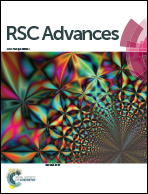Solvent-free electrospinning of UV curable polymer microfibers†
Abstract
The conventional solution electrospinning (e-spinning) process is facing the trouble of solvent recovery, especially for the industrial mass production of electrospun (e-spun) ultrathin fibers. This study provides a possible strategy, solvent-free e-spinning to solve this problem. By using a modified homemade e-spinning device and UV curable materials as the precursor liquid, all the spinning solution was successfully e-spun into ultrathin fibers without solvent evaporation (weight loss) in an atmosphere of nitrogen and under UV light radiation. The solidification mechanism of the fibers is ascribed to the quick curing of the acrylate bonds in the spinning stream under UV light radiation and without oxygen inhibition in the atmosphere of nitrogen. Such a break-through leads to fabrication of ultrathin fibers by solvent-free e-spinning without solution loss, and provides an eco-friendly approach to prepare new and functional (composite) ultrathin fibers by using a variety of UV curable materials and functional additions.


 Please wait while we load your content...
Please wait while we load your content...